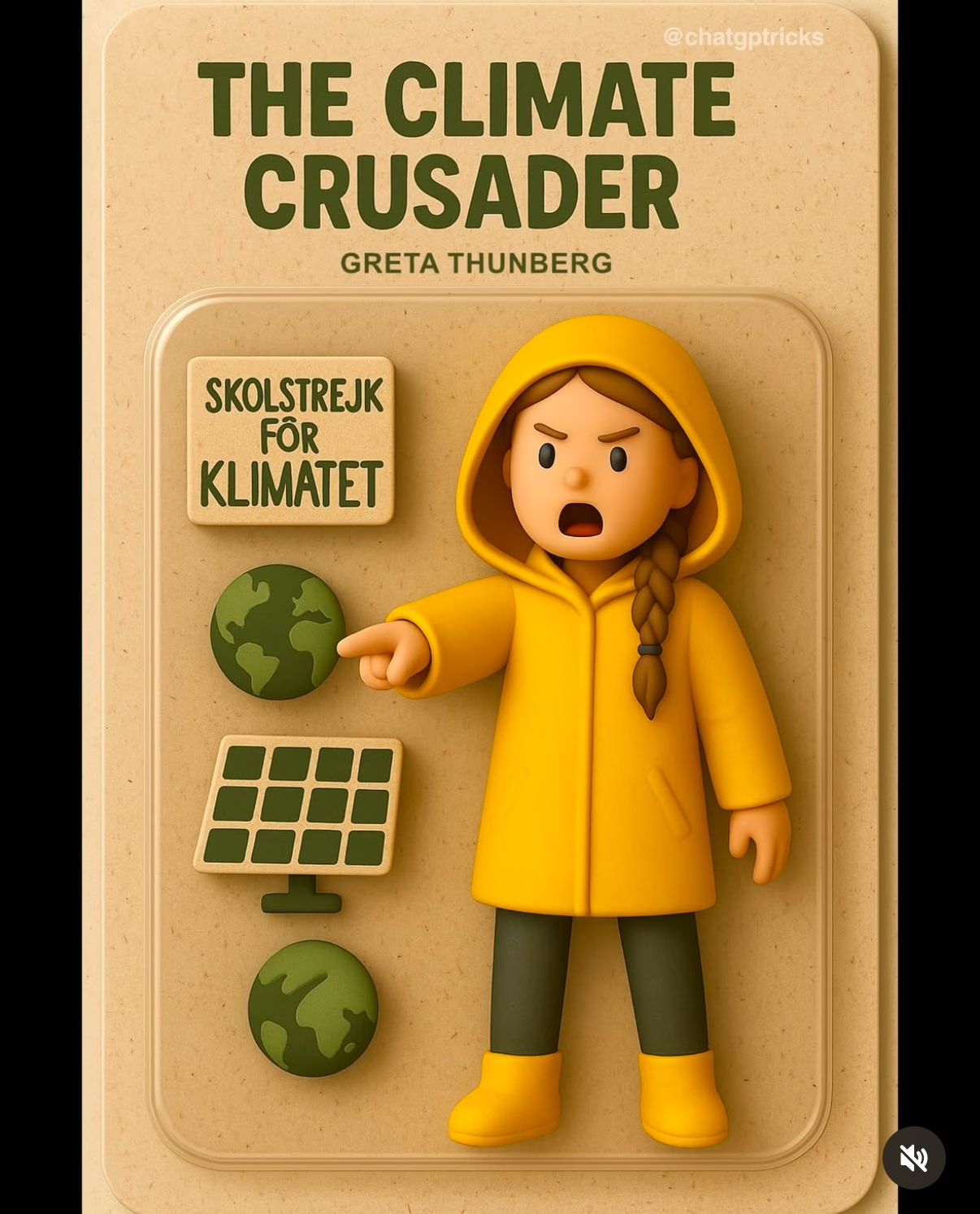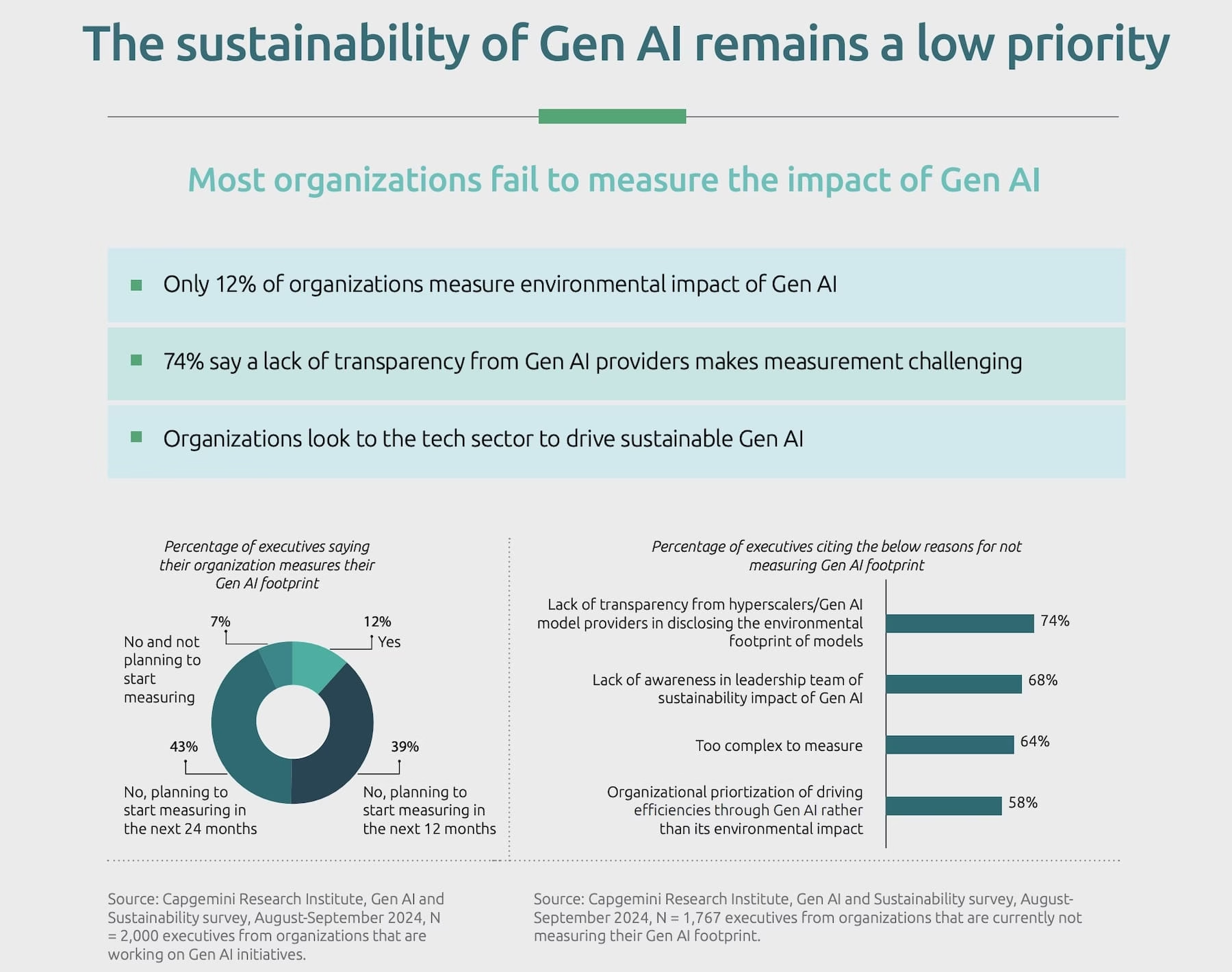AI is no longer the sci-fi future; it’s here and transforming our lives in real-time. And just like any other industry, it’s shaking up sustainability marketing. Done right, AI can help your brand save time, work smarter, and take your campaigns to the next level. But, there’s a balance to strike. Using AI comes with environmental and ethical costs, so it has to be used responsibly. Especially in an industry that’s so innately about sticking to limits.
Below, look at how to use AI effectively, ethically, and dare we say it, sustainably, to boost your marketing efforts.
1. Smart image, video and graphic creation
You’ll have seen some of the wild creations from AI doing the rounds on social media, from LinkedIn to Instagram and beyond. It’s not hyperbole to say that what you can create now with Gen AI is mindblowing. Take those viral images of people reimagined as action figures, on Linkedin. While getting a bit old now, those are pretty nifty and would be very, very time consuming to create from scratch.

By the time you’ve read there’ll be even fancier things getting passed around – and one key area where AI can help is with infographics and data visualizations.
Sustainability suits data visualizations, so it’s a great fit. And while it’s true that Gen AI does carry a significant health warning in that its emissions are high. You also have to consider that if you are a small team working for a sustainability startup, you can now achieve things that were out of reach before. Cool creations that were keeping you behind less sustainable companies with more resources.
It could be that you lower emissions for the same task if you can learn how to prompt AI to get a decent result quickly*. Something that’d take a week and involve a lot of folk could now take a single person a day. So the emissions argument for not using AI is a little more complex than it seems on the surface (but please also see the ‘owning the impact’ section, later in the post).
Videos, and animations, are another area to explore. But at Akepa we do not recommend creating articles for sustainability, from scratch. That’s a tactic that’s not quite as difficult to do and benefits from the personal experiences of a human. You don’t save so much time creating articles with AI, anyway. Still, if you are trying to build on content from AI then here’s another post from Akepa on how to edit and improve AI article content.
Key tool: ChatGPT’s new image generation skills make it hard to overlook, as it can also create infographics with skillful prompting. However, if you’re looking for a dedicated tool to create sustainability infographics and visualizations, then Piktochart has some decent Gen AI tools. Nevertheless, at the time of writing, this is a developing niche that no single tool has really nailed. Look out for some cool solutions over the coming year. Watch this space.
* Bear in mind results from ChatGPT aren’t iterative – you can’t ask ChatGPT to edit (yet) so you need to get it exactly right first time or take something that’s more or less right and then finish in in a package like Adobe Illustrator. Getting good at prompting is the key thing to get the desired result without getting into a doom loop of repeated prompts.
2. Better decisions with data
AI is a monster when it comes to data. It devours large datasets as if they were crumbs, processes data faster than we could ever hope to, and laughs out insights that would be hard to find. Need to analyze sustainability reports or figure out where your brand is falling short on environmental promises? AI tools can do all the heavy lifting, revealing insights you can act on without painful amounts of trawling.
Or, for another example, take AI chatbots, which can take all of the conversations received on something like an e-commerce website and transform all of that chatter into insightful, clear recommendations about how to find closer connections with customers.
These insights aren’t just useful for strategy or PowerPoint decks. They can support transparency, which is how you avoid the dreaded greenwashing (or greenhushing). If your brand’s sustainability claims hold water, AI can help you tell that story. If not, it’ll help you course-correct before customers call you out.
Key tools: Clarity.ai, which empowers you to rapidly assess and report on anything valuable to you and your clients – including regulatory requirements. For example, your brand’s alignment with the UN SDGs.
3. Automated meeting notes
When hopping on video calls, we’ve noticed a lot of clients, collaborators and potential clients using apps within online meetings to provide full audio and written transcriptions, along with detailed summaries and action items. This tool can be a big boost to efficiency – especially during meetings that involve multiple folk. After all, writing meeting notes and follow-up emails is hardly the most productive and creative use of a person’s time. It’s a natural place for AI to step in so that you can dedicate your time to more strategic work.
One important consideration if you plan to use such tools – especially in the realm of sustainability marketing, where ethics are paramount – is to make sure you obtain consent from participants beforehand. We recommend adding a consent question to call booking links to ensure transparency (and legal compliance) before each meeting. This doesn’t often happen in our experience and when not it can feel a little uncomfortable – especially considering that the apps can appear as unsolicited participants within the meetings.
Key tool: fireflies.ai is pretty popular at the moment because there’s a free version and it integrates well with platforms like Google Hangouts, Zoom and Microsoft Teams. It can also unlock insights and analytics from meeting notes.

4. Cleaner, greener, supply chains
Supply chains aren’t the most fun topic but they’re goldmines for improving sustainability. AI can root out inefficiencies, track suppliers’ environmental impact, and help cut waste.
How? Take carbon footprints, for example. AI tools can calculate the emissions – including tricky Scope 3 – for every step in your complex supply chain, helping you swap out high-impact practices or suppliers for better options. Want to market all that on your eco-friendly packaging? Well now you’ve got the proof to back it up. In fact, you could even take one of our earlier points on board and create an infographic from the evidence.
Key tool: BCome, whom we interviewed last year and have integrated AI into their technology, which helps fashion brands build sustainable supply chains.
5. A website built in record time
Because a lot of sustainable brands are start-ups, a first step that’s needed is branding and website design. Like everywhere else, this is an area where AI is starting to step in.
Website development, though, can be a back-breaking challenge. To help, Gen AI tools are starting to appear that can generate your website based on prompts, conceivably in minutes. You can combine that with some AI assistance on the branding side and then you’ve got the basics of your brand and website together, really quickly.
This approach doesn’t compare to crafting something really special with a human and some of the tools out there are still a bit flaky, but this is an area where AI is only going to get better. The approach is helpful for sustainability startups with limited budgets. In the future, a combination of Gen AI and human creativity is probably going to be the done thing.
One aspect to bear in mind is that your website should have marketing baked in from the get-go, so whatever system you use – make sure that aspects like SEO and Analytics are integrated, and that you cover it before (and while) you build the site. The last thing you want is to have to go back and do everything again because you have no flexibility on the SEO side, for example.
Key tool: We recently had a chat with a client, considering using Lovable to build their website. It gets good reviews and we’ll be taking a look at that with them over the coming weeks.
6. Personalization to reach conscious customers
One-size-fits-all marketing is a thing of the past because it just doesn’t work. Customers who care about sustainability want to know you share their vibe, and AI makes tailoring your messaging easier. By analyzing buying patterns and preferences, you can create campaigns and websites that speak directly to your audience.
Lookalike audiences use AI to identify target customers who’re similar to your existing ones. Sometimes this scouting may already be integrated within the ad platforms you’re using, such as Google Ads or Meta Ads, due to cookies becoming harder to use. But you can also use other dedicated platforms to laser in on those conscious consumers that you want to reach. For example, if your current audience engages with content about zero-waste living or follows eco-conscious influencers, lookalike audiences might include individuals who support ethical brands or actively seek sustainable alternatives in their purchasing decisions. This approach helps you connect with more people who appreciate your mission.
On your website, AI can also recommend products to current customers through website personalization. Let’s say someone’s browsing your site for vegan skincare, AI can suggest other products that person has a good chance of also caring about. But don’t be sneaky about this. If your products’ eco-credentials are solid, shout about them, but otherwise don’t employ AI like a dodgy salesman. AI is a tool to share your story, not sell snake oil.
Key tool: Enhencer is one of the first AI tools that targets ads at AI lookalike audiences, with some pretty strong success stories from brands like the World Wildlife Foundation.
7. Energy efficiency gets a boost
It’s inevitable, running a business burns energy but AI can help you burn less. Smart energy tools can keep your operations lean by optimizing how and when energy is used. This isn’t just good for the planet; it’s good for your bottom line and it can also help your marketing.
And here’s one of those fancy Pro Tips for marketers wrangling digital ads and platforms. AI can recommend ways to cut unnecessary energy use in campaigns by tweaking delivery timing or moving to more energy-efficient platforms. For instance, we’re considering swapping Mailchimp for Ecosend after an AI tip off.
Key tool: Pear.ai can help you optimize your company’s utility operations, which you can then shout about in your marketing. And for selecting new marketing tools, why not consult AI search tools like Perplexity.ai instead of endless searching (note: this may be a more energy efficient process than a load of consecutive searches anyway).
8. Owning the impact of AI
To tie everything you’re doing together, one final way you can use AI in your sustainability marketing is through measuring its impact. Yes, AI can be amazing but its environmental impact is nothing short of serious. Training and running massive models takes considerable energy, which comes with its own carbon footprint. That’s where transparency comes in.
But how to measure the emissions generated by your AI use? Many climate action providers offer tools to track this data. Once you know your numbers, share them openly with your audience. Whether you’re offsetting emissions or investing in renewable energy, be upfront about what you’re doing. This honesty not only builds trust but also shows you’re taking AI’s environmental impact seriously.
Do you have a sustainability certification that you’re promoting, which includes your emissions and attempts to reduce them, or compensate for them? If so, then make sure AI is incorporated in any calculations.
By doing this, your marketing’s going to the next level. A recent study from Capgemini found that despite widespread adoption of Gen AI, only 12% of executives using it have plans to measure its use.

On this topic, here’s another post from Akepa on the environmental impact of generative AI.
Key tool: at Akepa, we work with ClimatePartner to assess and reduce our emissions from AI use and have opened a conversation about tracking our AI use in 2025. If you’re working with a similar provider or tool – speak to the team to incorporate AI emissions into your calculations, and certifications. Be transparent about what you’ve measured and what you plan to do, to compensate.
Ethical AI in Action
Want to make the most of AI? Keep these tips in mind:
- Have a plan: Figure out exactly how AI can improve your sustainability efforts without adding unnecessary complexity.
- Stay honest: Use the data AI gives you to strengthen your sustainability mission, not dilute it.
- Find balance: Automate where it makes sense but don’t lose the human touch in your marketing.
- Collaborate smartly: Tools like Fireflies.ai can streamline communication but always get consent. Privacy breaches aren’t a good look in sustainability marketing.
- Learn and adjust: Regularly check how AI is helping (or not helping). Fix what needs fixing, and keep improving.
- Share the journey: Measure the impact as best you can and share how you’re using AI responsibly. It’s a great way to connect with your audience – especially when so few other brands are telling this story.
- Don’t get complacent: AI is an ongoing technological revolution. That means you need to be constantly monitoring what’s happening and how to best get involved. This is also why we’ll need to revisit this post every few months, lest it gets out of date.
Making sustainability smarter
AI might be a dilemma but use it wisely and it could be a force for good in sustainability marketing. It can cut waste, save energy, up your content game, and help you stand out from the crowd with tailored messaging. But more than that, using AI responsibly shows your brand is serious about making a difference – not just rushing to embrace new technologies like everyone else, without any mind to the consequences.
That’s smart, ethical, and exactly what great sustainability marketing should be.
Are you interested in using AI sustainably for your company? Then check out our AI for sustainability services.



Leave a Reply